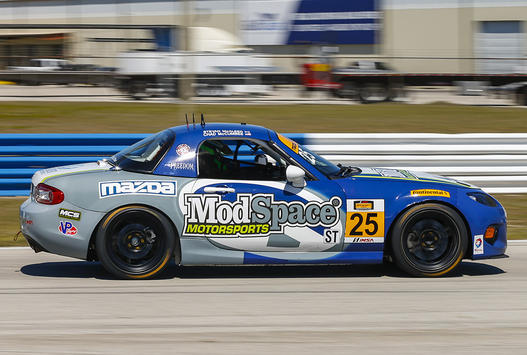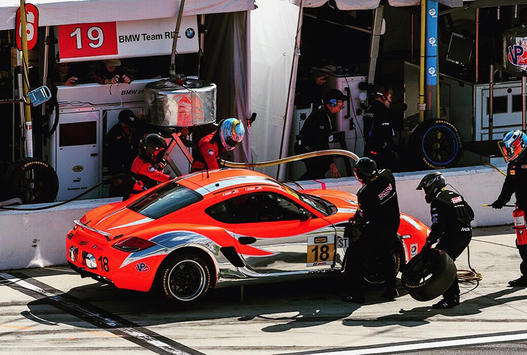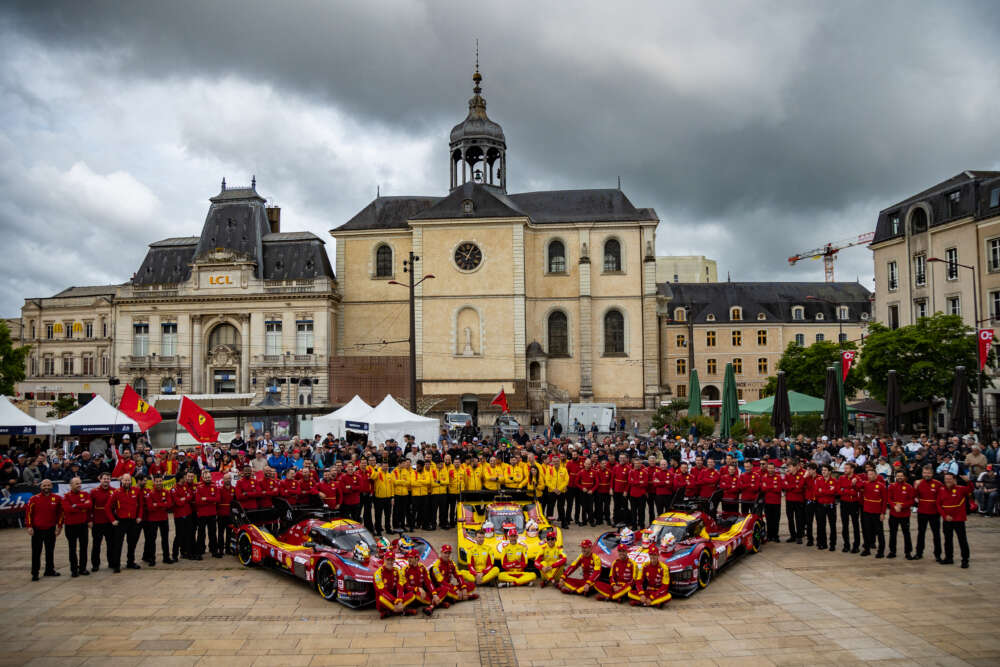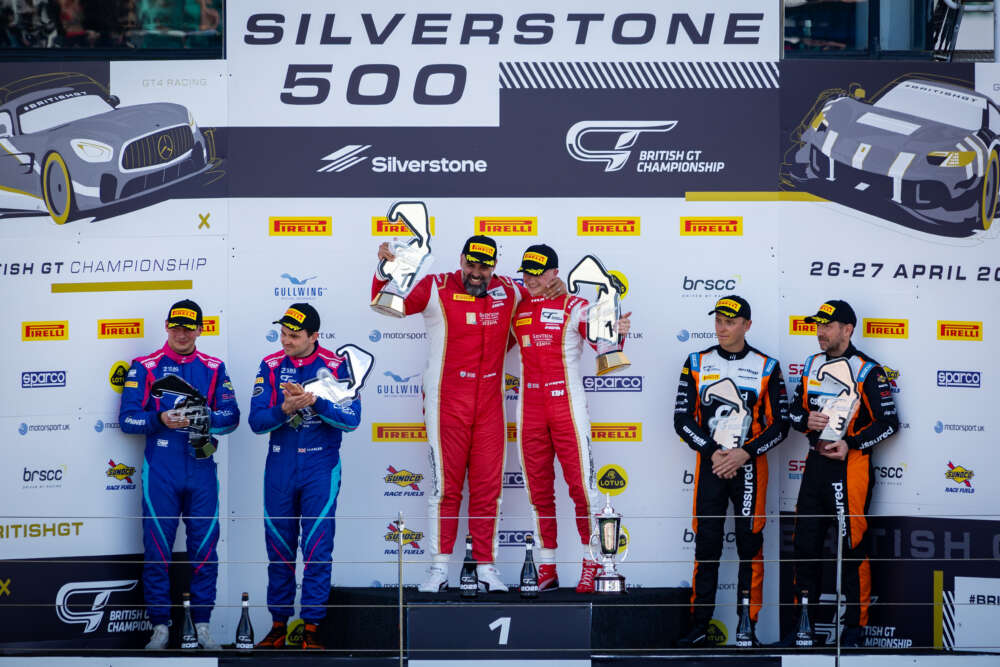Coopetition In Sports Car Racing
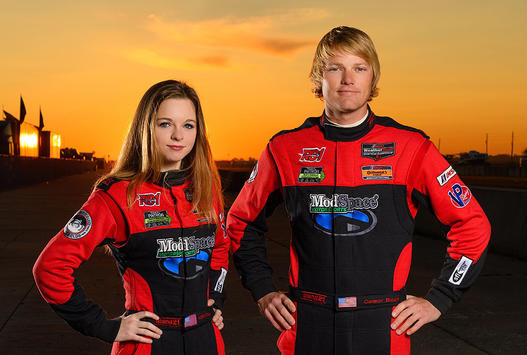
Written by Aurora Straus
*Aurora Straus reflects on the Continental Tire Challenge race at Sebring and a competitor’s show of sportsmanship towards a rival coming to the finish line
Racing can be a brutal demonstration of ego, a stage on which off-track friends become vicious rivals, and where acts of cooperation among competitors, like bump-drafting, appear gracious, but usually precede aggressive competitive maneuvers. The act of helping an on-track rival, especially without personal gain, is considered the antithesis of racing. Genuinely selfless gestures are rare and puzzling to fans – and other racers.
Fans watching the final moments of the recent IMSA Continental Tire SportsCar Challenge race at Sebring witnessed one of these rare, perplexing acts, as a Mazda MX-5 pushed a Porsche Cayman across the finish line. Even fellow competitors, armed with intimate knowledge of the two professional racers, Stevan McAleer and Connor Bloum, were understandably baffled by the illogical, self-defeating move. Weren’t these two drivers aggressively trading paint just weeks earlier at Daytona? Aren’t they on rival teams? Aren’t these rival manufacturers?
While the answer to all three of these questions is undeniably “yes,” I contend that this inexplicable act of “coopetition” may be one of the finest displays of heroic sportsmanship and maturity. Moreover, I believe that similar acts of coopetition will fuel interest and growth – among both fans and participants – in sportscar racing.
The assumed explanation – “Oh, they must be good friends” – is inaccurate. The factors that ultimately led to this strange circumstance are intertwined and complex.
For both drivers and fans, the Continental Tire Challenge is considered some of the best professional sports car racing in North America. It compresses the stress of endurance racing – including lightning-fast driver, fuel, and tire changes – into a two- to four-hour sprint race that punishes even the smallest errors. In this grueling arena, only the best survive, and battles among elite drivers and manufacturers are epic. Standing on the podium is extraordinary. Winning the championship is superhuman.
In 2015, Chad McCumbee and Stevan McAleer achieved this feat in their No. 25 ModSpace Mazda MX-5. In 2016, entering the final race of the season at Road Atlanta, Chad and Stevan, now racing with Freedom Autosport, had the points and momentum to win a historic second consecutive championship, but faced a potential spoiler by their season-long rivals, Nick Galante and Spencer Pumpelly in the No. 17 RS1 Porsche. Late in the race, the No. 25 experienced an unexpected engine failure that brought them to a halt, and the No. 17, under Spencer’s expert guidance, sped ahead to win both the race and the championship. The paddock was full of extreme emotions, ranging from elation to sorrow – and for me, both extremes simultaneously.
A few months ago, during the season-opening race at Daytona, the team rivalry between Freedom Autosport and RS1 was again on full display, this time between Freedom’s No. 25 ModSpace Mazda and RS1’s new entry – the No. 18 ModSpace car, piloted by Connor Bloum and myself. Stevan and Connor, two of the fastest drivers in sportscar racing, were battling as if a championship was already on the line.
As I watched Stevan and Connor clash on the track, I had mixed feelings because Stevan has been my mentor since the first time I sat behind the steering wheel of a car, at age 13. He taught me how to drive, then how to drive a manual shift, then how to drive a racecar, and then how to race that racecar. When Stevan and Chad formed McCumbee McAleer Racing, I drove on their team in the Battery Tender Global MX-5 Cup. Stevan is my mentor, my friend, and essentially part of my family. Yet here we were at Daytona, facing each other as competitors.
At Daytona, Connor and I finished a solid fourth in class among 20 competitors in the Street Tuner (ST) class, and entered Sebring determined to continue building points toward the championship. With the clock running out and ST cars on their final lap, Connor – who had fought our No. 18 up to 3rd place – began to stall within several hundred feet of the checkered flag. We had two gallons of fuel in the tank, but a mechanical issue caused our car to sputter as if it was dry.
The No. 25 ModSpace Mazda was a few laps down after being hit in the early stages of the race. None of the history between Freedom Autosport and RS1, the No. 25 and No. 18 cars, or Connor and Stevan, could have predicted that when he caught up to our stalling car, Stevan would make a split-second decision to push the No. 18 the remaining hundred feet across the finish line. I was elated, and I’m not ashamed to say I teared up in the pits as the two cars rolled past the checkered. It took a while to process the long-term brilliance and significance of Stevan’s move.
If NASCAR is fueled by fans thirsting for car-to-car contact, professional sportscar racing is fueled by personal connections – specifically, between career drivers, gentleman drivers, and supporting companies. Career drivers like Stevan and Connor focus on winning races, but also remain mindful of the personal connections that support their careers.
As Stevan approached our struggling No. 18, he didn’t see the driver or rival manufacturer he battled at Daytona. As Stevan explained, “I came around the corner, saw the #18 slowing to a crawl, looked down at the word ‘ModSpace’ on my suit, and decided to push.”
While some may characterize this decision as heroism, others may call it treason. There is no correct answer. One thing, however, is known: our mutual sponsor was ecstatic. Moreover, fans were entertained. As one superfan commented, “It was like watching the end of that Disney movie, Cars, when Lightning McQueen pushes his rival across the finish line, but McQueen becomes the true hero. It was the highlight of today’s race.”
The Continental Tire Challenge will continue to be defined by epic battles that sometimes result in endings that disappoint one team or the other, but we – sponsors, fans, drivers – need the courage and long-term strategic vision to balance our racers’ instincts for winning against the objectives of our sponsors and our sport. Small acts of coopetition among drivers, when appropriate, will further encourage gentleman drivers and sponsors to continue and expand their engagement with and support of sportscar racing. There will always be plenty of fast drivers looking for support, but sponsors will be looking for the next McQueen – or McAleer – who shows courage and vision when it matters the most.
About The Author
Aurora Straus is a senior in high school with a passion for automotive racing, music, and teaching. When not studying or playing her own music, she competes in the No. 18 RS1 ModSpace Cayman in the IMSA Continental Tire SportsCar Challenge. Aurora is currently the only female teenage racecar driver competing professionally full-time in North America. She has been accepted into Harvard University’s Class of 2021 and plans to pursue degrees in both Mechanical Engineering and English Literature.
Source : imsa.com
